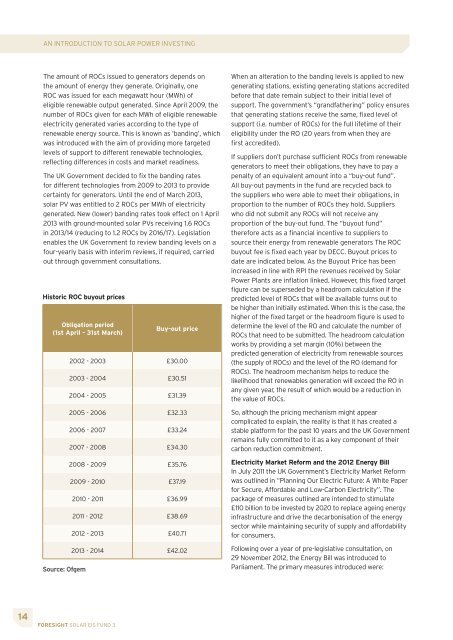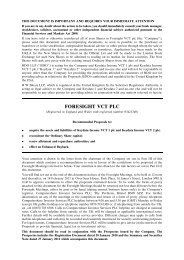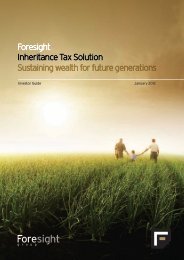Information Memorandum - Foresight Group
Information Memorandum - Foresight Group
Information Memorandum - Foresight Group
Create successful ePaper yourself
Turn your PDF publications into a flip-book with our unique Google optimized e-Paper software.
AN INTRODUCTION TO SOLAR POWER INVESTING<br />
The amount of ROCs issued to generators depends on<br />
the amount of energy they generate. Originally, one<br />
ROC was issued for each megawatt hour (MWh) of<br />
eligible renewable output generated. Since April 2009, the<br />
number of ROCs given for each MWh of eligible renewable<br />
electricity generated varies according to the type of<br />
renewable energy source. This is known as ‘banding’, which<br />
was introduced with the aim of providing more targeted<br />
levels of support to different renewable technologies,<br />
reflecting differences in costs and market readiness.<br />
The UK Government decided to fix the banding rates<br />
for different technologies from 2009 to 2013 to provide<br />
certainty for generators. Until the end of March 2013,<br />
solar PV was entitled to 2 ROCs per MWh of electricity<br />
generated. New (lower) banding rates took effect on 1 April<br />
2013 with ground-mounted solar PVs receiving 1.6 ROCs<br />
in 2013/14 (reducing to 1.2 ROCs by 2016/17). Legislation<br />
enables the UK Government to review banding levels on a<br />
four-yearly basis with interim reviews, if required, carried<br />
out through government consultations.<br />
Historic ROC buyout prices<br />
Obligation period<br />
(1st April - 31st March)<br />
Source: Ofgem<br />
14 FORESIGHT SOLAR EIS FUND 3<br />
Buy-out price<br />
2002 - 2003 £30.00<br />
2003 - 2004 £30.51<br />
2004 - 2005 £31.39<br />
2005 - 2006 £32.33<br />
2006 - 2007 £33.24<br />
2007 - 2008 £34.30<br />
2008 - 2009 £35.76<br />
2009 - 2010 £37.19<br />
2010 - 2011 £36.99<br />
2011 - 2012 £38.69<br />
2012 - 2013 £40.71<br />
2013 - 2014 £42.02<br />
When an alteration to the banding levels is applied to new<br />
generating stations, existing generating stations accredited<br />
before that date remain subject to their initial level of<br />
support. The government’s “grandfathering” policy ensures<br />
that generating stations receive the same, fixed level of<br />
support (i.e. number of ROCs) for the full lifetime of their<br />
eligibility under the RO (20 years from when they are<br />
first accredited).<br />
If suppliers don’t purchase sufficient ROCs from renewable<br />
generators to meet their obligations, they have to pay a<br />
penalty of an equivalent amount into a “buy-out fund”.<br />
All buy-out payments in the fund are recycled back to<br />
the suppliers who were able to meet their obligations, in<br />
proportion to the number of ROCs they hold. Suppliers<br />
who did not submit any ROCs will not receive any<br />
proportion of the buy-out fund. The “buyout fund”<br />
therefore acts as a financial incentive to suppliers to<br />
source their energy from renewable generators The ROC<br />
buyout fee is fixed each year by DECC. Buyout prices to<br />
date are indicated below. As the Buyout Price has been<br />
increased in line with RPI the revenues received by Solar<br />
Power Plants are inflation linked. However, this fixed target<br />
figure can be superseded by a headroom calculation if the<br />
predicted level of ROCs that will be available turns out to<br />
be higher than initially estimated. When this is the case, the<br />
higher of the fixed target or the headroom figure is used to<br />
determine the level of the RO and calculate the number of<br />
ROCs that need to be submitted. The headroom calculation<br />
works by providing a set margin (10%) between the<br />
predicted generation of electricity from renewable sources<br />
(the supply of ROCs) and the level of the RO (demand for<br />
ROCs). The headroom mechanism helps to reduce the<br />
likelihood that renewables generation will exceed the RO in<br />
any given year, the result of which would be a reduction in<br />
the value of ROCs.<br />
So, although the pricing mechanism might appear<br />
complicated to explain, the reality is that it has created a<br />
stable platform for the past 10 years and the UK Government<br />
remains fully committed to it as a key component of their<br />
carbon reduction commitment.<br />
Electricity Market Reform and the 2012 Energy Bill<br />
In July 2011 the UK Government’s Electricity Market Reform<br />
was outlined in “Planning Our Electric Future: A White Paper<br />
for Secure, Affordable and Low-Carbon Electricity”. The<br />
package of measures outlined are intended to stimulate<br />
£110 billion to be invested by 2020 to replace ageing energy<br />
infrastructure and drive the decarbonisation of the energy<br />
sector while maintaining security of supply and affordability<br />
for consumers.<br />
Following over a year of pre-legislative consultation, on<br />
29 November 2012, the Energy Bill was introduced to<br />
Parliament. The primary measures introduced were:

















